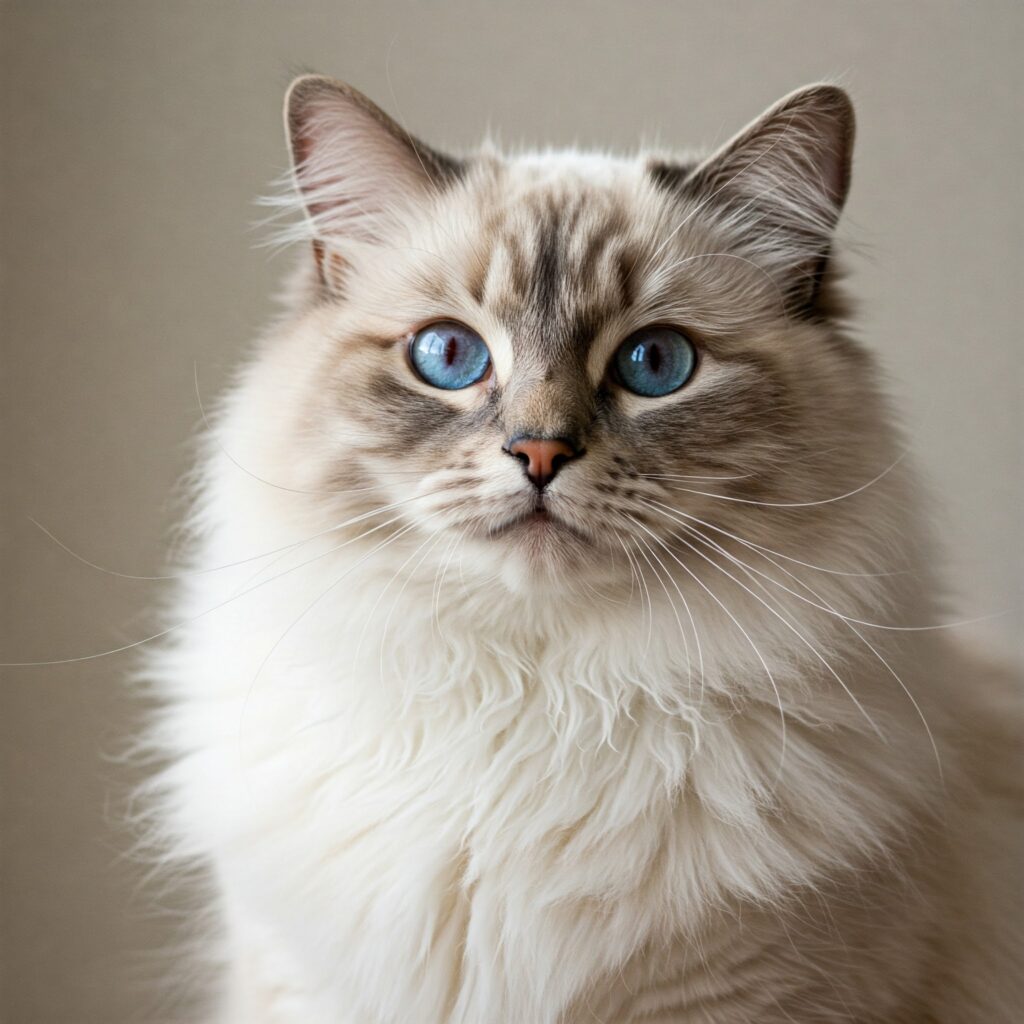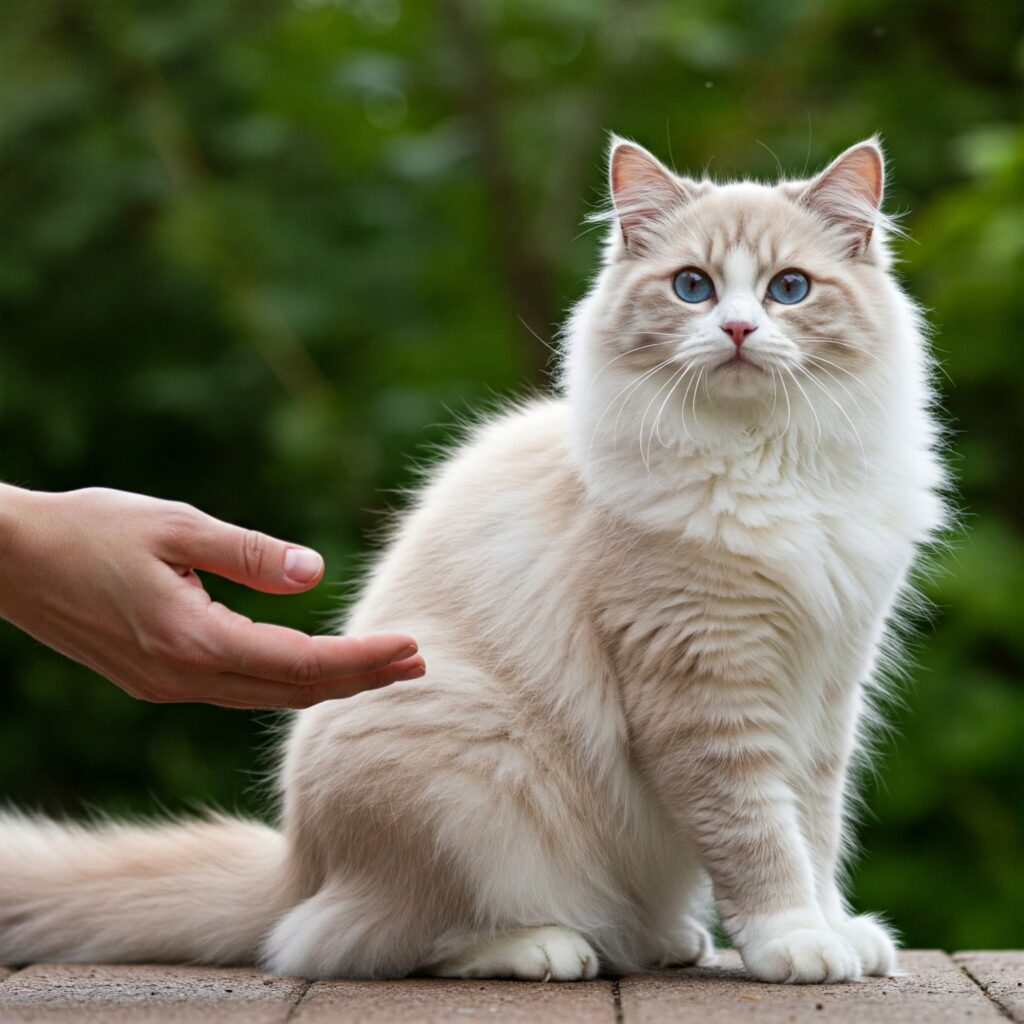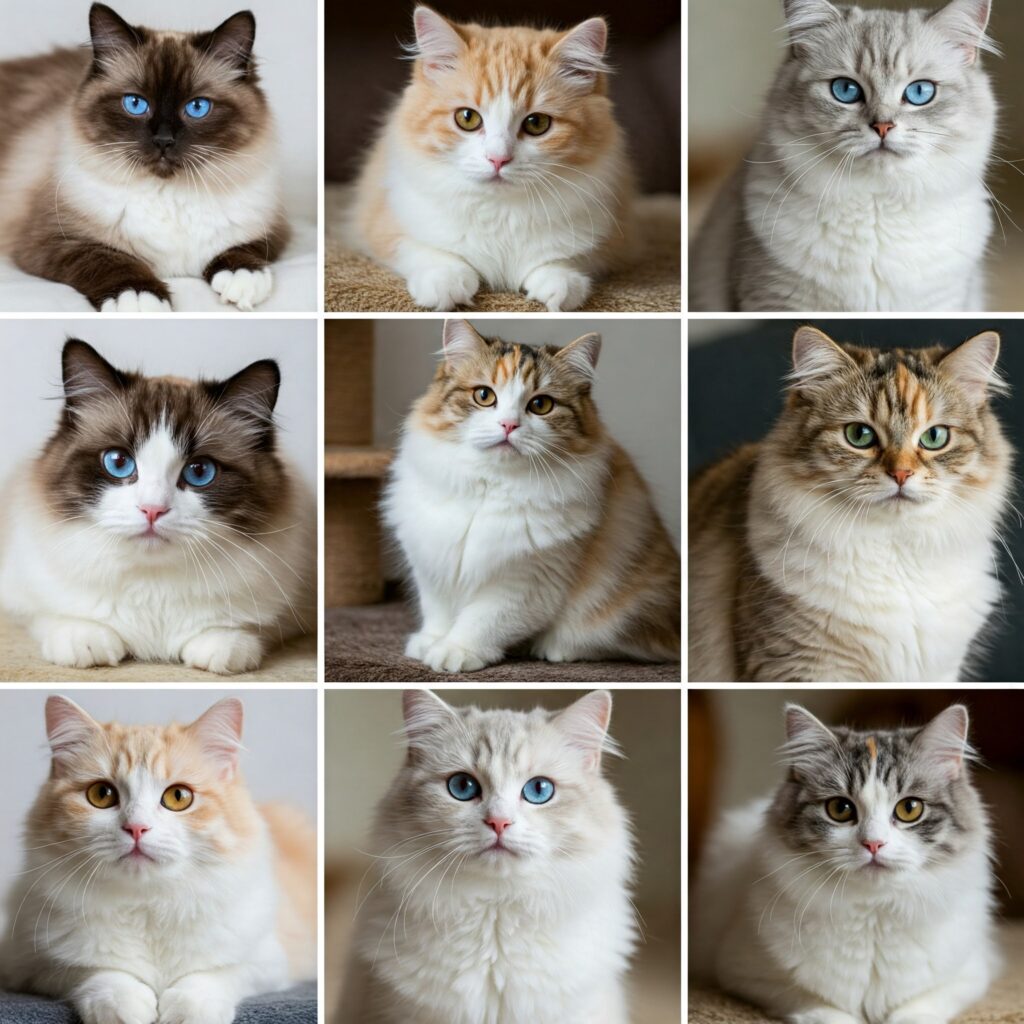Discover why this fluffy feline might be the perfect addition to your family

Introduction
Have you ever met a cat that melts into your arms like warm butter? A feline so docile it actually enjoys being cradled like a baby? If not, allow me to introduce you to the Ragamuffin—a gentle giant of the cat world that’s stealing hearts across America with its puppy-like devotion and plush, huggable coat.
As someone who’s spent countless hours researching (and yes, cuddling) various cat breeds, I can tell you that Ragamuffins are something special. They’re not just pets; they’re emotional support animals disguised as luxury throw pillows. And while they might not be as widely recognized as their cousins, the Ragdolls, these magnificent felines deserve their moment in the spotlight.
So, kick back, maybe with your own furry friend purring beside you, and let’s explore everything you need to know about the captivating Ragamuffin cat breed.
What Exactly Is a Ragamuffin Cat?

The Ragamuffin is a relatively new breed that’s essentially the result of cat lovers saying, “What if we could make an even more huggable version of the Ragdoll?” Think of them as the feline equivalent of that ultra-plush bathrobe you never want to take off—large, soft, and incredibly comforting.
Physically, Ragamuffins are substantial cats with sturdy, rectangular bodies, broad chests, and powerful shoulders. Males typically weigh between 15-20 pounds, while females are slightly smaller at 10-15 pounds. They’re not just big—they’re gloriously fluffy, with semi-longhaired coats that feel like silk and come in virtually every color and pattern imaginable.
But what truly sets the Ragamuffin apart isn’t just their teddy bear appearance—it’s their remarkably docile temperament. If cats were people, Ragamuffins would be that friend who’s always down for a Netflix marathon and never complains about anything.
The Ragamuffin vs. Ragdoll Debate: Spotting the Differences
One question I hear constantly is, “Aren’t Ragamuffins just Ragdolls with a different name?” While these breeds share ancestry and certain traits (including their signature “floppiness”), there are notable differences between them.
| Feature | Ragamuffin | Ragdoll |
|---|---|---|
| Body Type | More substantial with broader chest | Slightly more slender |
| Coat Colors/Patterns | All colors and patterns accepted | Traditional pointed patterns predominate |
| Face Shape | Rounder with walnut-shaped eyes | More wedge-shaped with oval eyes |
| Gene Pool | More diverse genetic background | More restricted breeding standards |
| Maturity Rate | Fully mature at 4-5 years | Fully mature at 3-4 years |
The Ragamuffin breed actually developed when some Ragdoll breeders wanted to expand the breed’s genetic diversity and color options. In 1994, they split off and established the Ragamuffin as a separate breed. Think of it as the slightly more relaxed cousin who doesn’t care quite as much about family traditions.
The Heart and Soul of a Ragamuffin: Personality Traits

If I had to sum up a Ragamuffin’s personality in one word, it would be “accommodating.” These cats seem to have missed the memo about feline aloofness. Instead, they’ve adopted an almost dog-like devotion to their humans.
Ragamuffins are characterized by:
- Extraordinary patience – They tolerate being dressed up, carried around, and generally manhandled with saint-like tolerance
- Intense affection – Expect a furry shadow that follows you from room to room
- Intelligence with a laid-back attitude – Smart enough to learn tricks but not neurotic about mental stimulation
- Deep loyalty – They form strong bonds with their family members
- Adaptability – They adjust well to new situations and environments
I once met a Ragamuffin named Milo who would greet guests at the door like a furry butler, then escort them to the couch where he would promptly flop into their laps. His owner joked that he was “part doormat, part welcome committee.” That’s the Ragamuffin way—they’re pleasers by nature.
Despite their easy-going temperament, they’re not completely devoid of playfulness. They simply prefer gentle games over wild antics. Think of them as more of a chess player than an Olympic sprinter—deliberate, thoughtful, and strategic in their movements.
Living With a Ragamuffin: Lifespan and Health Considerations
When you bring a Ragamuffin into your home, you’re committing to a long-term relationship. These cats typically enjoy a lifespan of 12-16 years, though with excellent care, some have been known to reach their early 20s.
As with any purebred cat, there are some health issues to be aware of:
- Hypertrophic cardiomyopathy – A form of heart disease that can be genetic
- Polycystic kidney disease – More common in related breeds but still something to watch for
- Obesity – Their laid-back nature means they’re prone to packing on pounds
The good news? Responsible breeders screen for genetic conditions, and Ragamuffins are generally considered a robust breed. Still, regular veterinary check-ups and a balanced diet are essential for keeping your fluffy friend in top shape.
“Ragamuffins aren’t just genetically blessed with gorgeous coats—they also tend to be healthier than many other purebreds,” notes Dr. Sarah Williams, a feline specialist I consulted. “But their relaxed attitude means owners need to be proactive about keeping them active.”
Family Matters: Are Ragamuffins Good With Children and Other Pets?
![Insert image of a Ragamuffin cat interacting peacefully with a child or other pet]
If the Ragamuffin had a LinkedIn profile, “Works well with others” would be prominently featured in their skills section. These cats are practically designed for family life, making them ideal companions for households with children and other pets.
Their patience is legendary—many Ragamuffin owners report their cats tolerating everything from clumsy toddler hugs to the curious nudges of family dogs with remarkable grace. Unlike more skittish breeds, they rarely respond to rough handling with scratches or bites, preferring to simply wriggle away if truly uncomfortable.
That said, I always emphasize that proper introductions are still important. Even the most tolerant cat deserves respect, and children should be taught how to interact appropriately with their furry friends.
As for other animals, Ragamuffins typically get along well with:
- Dogs (especially those who respect boundaries)
- Other cats (they’re rarely territorial)
- Even small pets like rabbits or guinea pigs (though supervision is always recommended)
Their non-confrontational nature means they’re more likely to walk away from potential conflicts than engage in them. It’s like they’ve taken a feline diplomacy course—always choosing peace over drama.
The Ragamuffin’s Magnificent Coat: Grooming Needs and Challenges
That glorious, silky coat that makes Ragamuffins so huggable does come with some maintenance requirements. However, you’ll be pleased to know that grooming a Ragamuffin is less intensive than you might expect for a longhaired breed.
Their medium-to-long fur lacks the dense undercoat that makes some breeds prone to severe matting. Instead, their hair is more like rabbit fur—soft, silky, and less likely to tangle. Still, regular grooming sessions are essential to keep them looking their best.
A typical Ragamuffin grooming routine includes:
- Brushing 2-3 times per week with a stainless steel comb or slicker brush
- Daily brushing during seasonal shedding periods (typically spring and fall)
- Occasional baths (every few months) using a cat-specific shampoo
- Regular nail trimming (every 2-3 weeks)
- Dental care including tooth brushing or dental treats
“The trick with Ragamuffins,” shares experienced breeder Jennifer Moore, “is to establish grooming routines when they’re kittens. Their amenable nature makes them surprisingly accepting of grooming, especially if you make it a bonding experience.”
A Rainbow of Fluff: Colors and Patterns of Ragamuffin Cats

One of the Ragamuffin’s most charming features is the incredible variety of coat colors and patterns they come in. Unlike some breeds with strict color standards, Ragamuffins are a veritable feline rainbow.
Common Ragamuffin colors include:
- Solid colors (white, black, blue, cream, red)
- Tortoiseshell and calico
- Tabby patterns (classic, mackerel, spotted)
- Pointed patterns (similar to Siamese coloration)
- Mink and sepia patterns
- Bi-color and tri-color combinations
What’s particularly fascinating is how a Ragamuffin’s coat can change over time. Kittens often start with lighter colors that deepen as they mature. And those with temperature-sensitive coloration (like pointed patterns) may appear different depending on the season!
When selecting a Ragamuffin, the color options are so vast that it really comes down to personal preference. You want a cat that looks like a tiny snow leopard? There’s probably a Ragamuffin pattern for that. Prefer something that matches your furniture to hide the inevitable cat hair? They’ve got you covered there too.
The Sneeze Factor: Are Ragamuffins Hypoallergenic?
Let’s address a common question straight away: No, Ragamuffins are not hypoallergenic cats. Despite their luxurious coats, the allergen issue isn’t actually about the fur itself but about proteins in the cat’s saliva and skin secretions.
That said, some allergy sufferers report having fewer reactions to Ragamuffins than to other breeds. This could be due to:
- Individual variation in how much allergenic protein each cat produces
- Their relatively low-maintenance coats that may trap fewer allergens
- Their cleanliness—Ragamuffins are typically fastidious groomers
If you’re allergic but have your heart set on a Ragamuffin, consider these strategies:
- Spend time with the breed before committing
- Use HEPA air purifiers in your home
- Establish cat-free zones, particularly in bedrooms
- Implement regular grooming to reduce loose hair and dander
I know a couple where one partner has moderate cat allergies but fell in love with a Ragamuffin at a cat show. With careful management—including weekly baths for the cat, which the placid Ragamuffin tolerated beautifully—they’ve built a happy life together. It’s not guaranteed to work for everyone, but it demonstrates the possibilities.
From Ragdoll to Ragamuffin: The History and Origin of the Breed
The Ragamuffin’s story begins with another breed—the Ragdoll—developed in the 1960s by Ann Baker in California. The original Ragdolls were known for their docile, floppy nature (hence the name), and distinctive pointed coloration.
By the early 1990s, disagreements within the Ragdoll breeding community led to a split. A group of breeders wanted to:
- Expand the accepted color patterns beyond the traditional pointed varieties
- Broaden the genetic pool for better health
- Create more independent breeding standards
This group began developing what would become the Ragamuffin, officially recognized by the Cat Fanciers’ Association (CFA) in 2011. The name “Ragamuffin” was chosen as a playful nod to their Ragdoll origins while establishing them as their own distinct breed.
What’s particularly interesting about the Ragamuffin’s development is how purposeful it was. Breeders specifically selected for:
- Exceptionally sweet temperaments
- Robust health and longevity
- Varied coat colors and patterns
- That signature plush coat texture
It’s a relatively young breed, but one that’s been gaining steady popularity as more cat enthusiasts discover their remarkable personalities.
Investment in Joy: The Cost of Owning a Ragamuffin Cat

Let’s talk numbers. Bringing a Ragamuffin into your life isn’t the most budget-friendly cat option, but many owners will tell you they’re worth every penny.
A Ragamuffin kitten from a reputable breeder typically costs between $800 and $1,500, though show-quality specimens from championship lines can run $2,000 or more. Adult Ragamuffins are occasionally available for adoption at lower costs, though they’re relatively rare in rescue situations due to their desirable nature.
Beyond the initial purchase price, potential owners should budget for:
- High-quality food ($30-50 monthly) to maintain their health and coat condition
- Regular veterinary care ($200-400 annually for routine visits)
- Grooming supplies ($50-100 initially, then replacements as needed)
- Large cat furniture ($100-300) to accommodate their substantial size
- Toys and enrichment ($10-30 monthly)
“Quality breeding isn’t cheap,” explains respected Ragamuffin breeder Thomas Jenkins. “The higher price reflects genetic testing, excellent veterinary care for queens and kittens, and the time invested in socializing these kittens perfectly.”
When seeking a Ragamuffin, be wary of prices that seem too good to be true. Extremely low prices often indicate backyard breeding with little attention to health or temperament. Remember: you’re not just paying for a cat; you’re investing in a decade-plus of companionship.
Living Your Best Life With a Ragamuffin: Care Tips and Recommendations
To help your Ragamuffin thrive, consider implementing these care strategies:
1. Create vertical space Despite their laid-back nature, Ragamuffins enjoy observing their domain from above. Sturdy cat trees, wall shelves, or window perches designed for larger cats provide perfect vantage points.
2. Establish gentle play routines While not as naturally athletic as some breeds, Ragamuffins benefit from regular play sessions. Feather wands, puzzle toys, and soft balls are usually winners.
3. Monitor food intake Their easygoing temperament makes them prone to weight gain. Measured feeding and regular weigh-ins help keep them at a healthy size.
4. Provide companionship Ragamuffins are social creatures that don’t thrive in isolation. If you’re frequently away, consider getting two cats or ensuring someone can check in regularly.
5. Make grooming pleasurable Turn brushing sessions into bonding time with treats and affection. Many Ragamuffins actually enjoy being groomed when it’s approached positively.
For those looking to enhance their Ragamuffin’s living environment, here are some product recommendations that align perfectly with their needs:
- Cat Tower for Large Cats – Provides exercise and entertainment specifically designed for larger breeds like the Ragamuffin
- Stainless Steel Cat Comb – Ideal for maintaining their silky coat and preventing mats
- Plush Cat Bed – Offers a comfortable resting spot worthy of this luxury breed
- Water Fountain for Cats – Encourages proper hydration, which supports coat health
- Interactive Cat Toys – Keeps these intelligent but low-energy cats mentally stimulated
Conclusion: Is a Ragamuffin Right for You?
After diving deep into the world of Ragamuffins, the question remains: is this the right breed for your home? These gentle giants offer extraordinary affection, compatibility with families, and stunning beauty. However, they do require financial commitment, space, and regular grooming attention.
You might be perfect for a Ragamuffin if:
- You value affection and companionship over feline independence
- You have the time and desire for regular grooming sessions
- You’re looking for a cat that integrates seamlessly with children or other pets
- You appreciate a quieter, less athletic feline companion
- You’re willing to make a decade-plus commitment
The Ragamuffin isn’t just another pretty face in the cat world—it’s a breed that redefines what it means to be a feline companion. They offer the beauty and grace we expect from cats, coupled with the devoted affection more commonly associated with dogs.
If you decide to welcome a Ragamuffin into your life, prepare to have your definition of cat ownership transformed. These living plush toys with hearts of gold have a way of turning even the most dedicated “dog person” into a cat enthusiast.
Have you encountered a Ragamuffin cat? Are you considering adding one to your family? Share your experiences or questions in the comments below—I’d love to hear your thoughts on these magnificent felines!
